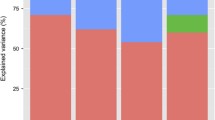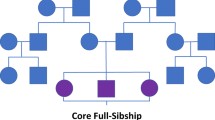Abstract
Purpose
Both epidemiological and genetically informative studies indicate that shared environmental influences contribute to resemblance in siblings for drug abuse (DA). To what degree do these influences arise from living in the same household versus residing in the same community?
Methods
We performed a cross-classified multi-level logistic regression on all individuals born in Sweden 1975–1990 (N = 1558,654). We assessed the proportion of the total population variation in DA that was due to household versus community effects controlling for genetic resemblance. DA was assessed from medical, criminal and pharmacy records.
Results
Expressed as an intraclass correlation (ICC), the combined household/community effects accounted for ~8 % of the total population variation in DA. The variance attributed to the community was greater than that seen for household (4.5 versus 3.4 %). In males, the variance components were slightly larger and nearly equal at the community (5.3 %) and household level (5.1 %). In females, household effects (4.8 %) were stronger than those arising from the community (3.2 %).
Conclusion
In the total population and among males, community effects on DA were somewhat more potent than household effects. However, in females, household effects on DA were stronger than community effects. In Sweden, shared environmental effects for DA arise both at the household and at the community level. Community effects on DA are more potent in males than in females.
Similar content being viewed by others
References
World Health Organization. Atlas on substance use (2010) Resources for the prevention and treatment of substance use disorders. 2010 [NLM classification: WM 270]. WHO Library Cataloguing-in-Publication Data, WHO Press
Tsuang MT, Lyons MJ, Eisen SA, Goldberg J, True W, Lin N, Meyer JM, Toomey R, Faraone SV, Eaves L (1996) Genetic influences on DSM-III-R drug abuse and dependence: a study of 3,372 twin pairs. Am J Med Genet 67:473–477
van den Bree MB, Johnson EO, Neale MC, Pickens RW (1998) Genetic and environmental influences on drug use and abuse/dependence in male and female twins. Drug Alcohol Depend 52:231–241
Kendler KS, Prescott CA (1998) Cannabis use, abuse, and dependence in a population-based sample of female twins. AJP 155:1016–1022
Lynskey MT, Heath AC, Nelson EC, Bucholz KK, Madden PA, Slutske WS, Statham DJ, Martin NG (2002) Genetic and environmental contributions to cannabis dependence in a national young adult twin sample. Psychol Med 32:195–207
Kendler KS, Karkowski LM, Neale MC, Prescott CA (2000) Illicit psychoactive substance use, heavy use, abuse, and dependence in a US population-based sample of male twins. Arch Gen Psychiatry 57:261–269
Kendler KS, Sundquist K, Ohlsson H, Palmer K, Maes H, Winkleby MA, Sundquist J (2012) Genetic and familial environmental influences on the risk for drug abuse: a national Swedish adoption study. Arch Gen Psychiatry 69:690–697
Faris RE, Dunham HW (1939) Mental disorders in urban areas: an ecological study of schizophrenia and other psychoses. University of Chicago Press, Chicago
Compton WM, Thomas YF, Stinson FS, Grant BF (2007) Prevalence, correlates, disability, and comorbidity of DSM-IV drug abuse and dependence in the United States: results from the national epidemiologic survey on alcohol and related conditions. Arch Gen Psychiatry 64:566–576
Muntaner C, Eaton WW, Diala C, Kessler RC, Sorlie PD (1998) Social class, assets, organizational control and the prevalence of common groups of psychiatric disorders. Soc Sci Med 47:2043–2053
Warner LA, Kessler RC, Hughes M, Anthony JC, Nelson CB (1995) Prevalence and correlates of drug use and dependence in the United States. Results from the national comorbidity survey. Arch Gen Psychiatry 52:219–229
Kendler KS, Ohlsson H, Sundquist K, Sundquist J (2014) Peer deviance, parental divorce, and genetic risk in the prediction of drug abuse in a nationwide Swedish sample: evidence of environment-environment and gene-environment interaction. JAMA Psychiatry 71:439–445
Dohrenwend BP, Levav I, Shrout PE, Schwartz S, Naveh G, Link BG, Skodol AE, Stueve A (1992) Socioeconomic status and psychiatric disorders: the causation-selection issue. Science 255:946–952
Sareen J, Afifi TO, McMillan KA, Asmundson GJ (2011) Relationship between household income and mental disorders: findings from a population-based longitudinal study. Arch Gen Psychiatry 68:419–427
Kendler KS, Ohlsson H, Sundquist K, Sundquist J (2014) The causal nature of the association between neighborhood deprivation and drug abuse: a prospective national Swedish co-relative control study. Psychol Med 44(12):2537–2546
Kendler KS, Maes HH, Sundquist K, Ohlsson H, Sundquist J (2013) Genetic and family and community environmental effects on drug abuse in adolescence: a Swedish national twin and sibling study. AJP 171:209–217
Kendler KS, Ohlsson H, Sundquist K, Sundquist J (2013) Within-family environmental transmission of drug abuse: a Swedish national study. JAMA Psychiatry 70:235–242
Bobashev GV, Anthony JC (1998) Clusters of marijuana use in the United States. Am J Epidemiol 148:1168–1174
Petronis KR, Anthony JC (2000) Perceived risk of cocaine use and experience with cocaine: do they cluster within US neighborhoods and cities? Drug Alcohol Depend 57:183–192
Delva J, Bobashev G, Gonzalez G, Cedeno M, Anthony JC (2000) Clusters of drug involvement in Panama: results from Panama’s 1996 national youth survey. Drug Alcohol Depend 60:251–257
Goldstein H (2003) Multilevel statistical models, 3rd edn. Hodder Arnold, London
Goldstein H, Browne W, Rasbash J (2002) Partitioning variation in generalised linear multilevel models. Underst Stat 1:223–232
Wu S, Crespi CM, Wong WK (2012) Comparison of methods for estimating the intraclass correlation coefficient for binary responses in cancer prevention cluster randomized trials. Contemp Clin Trials 33:869–880
Lunn DJ, Thomas A, Best N, Spiegelhalter D (2000) WinBUGS-a Bayesian modelling framework: concepts, structure, and extensibility. Stat Comput 10:325–337
Rasbash J, Charlton C, Brown WJ, Healy M, Cameron B (2009) MCMC estimation in MLwiN [computer program]. Version 2.1 Centre for multilevel modelling. University of Bristol
Rose RJ, Viken RJ, Dick DM, Bates JE, Pulkkinen L, Kaprio J (2003) It does take a village: nonfamilial environments and children’s behavior. Psychol Sci 14:273–277
Graziano F, Bina M, Giannotta F, Ciairano S (2012) Drinking motives and alcoholic beverage preferences among Italian adolescents. J Adolesc 35:823–831
Borsari B, Carey KB (2001) Peer influences on college drinking: a review of the research. J Subst Abuse 13:391–424
Svensson R (2003) Gender differences in adolescent drug use—the impact of parental monitoring and peer deviance. Youth Soc 34:300–329
Kraus L, Augustin R, Frischer M, Kummler P, Uhl A, Wiessing L (2003) Estimating prevalence of problem drug use at national level in countries of the European Union and Norway. Addiction 98:471–485
Hibell B, Guttormsson U, Ahlstrom S, Balakireva O, Bjarnason T, Kokkevi A, Kraus L (2007) The 2007 ESPAD report: substance use among students in 35 European countries. The Swedish Council for Information on Alcohol and Other Drugs (CAN), Stockholm, Sweden
American Psychiatric Association (1987) Diagnostic and statistical manual of mental disorders, revised, 3rd edn. American Psychiatric Association, Washington
Kringlen E, Torgersen S, Cramer V (2001) A Norwegian psychiatric epidemiological study. AJP 158:1091–1098
Braumoeller B (2006) Explaining variance: or, stuck in a moment we can’t get out of. Polit Anal 14:268–290
Downs G, Rocke D (1979) Interpreting heteroscedasticity. Am J Polit Sci 23:816–828
Lewontin RC (2006) The analysis of variance and the analysis of causes. 1974. Int J Epidemiol 35:520–525
Chaix B, Rosvall M, Merlo J (2007) Neighborhood socioeconomic deprivation and residential instability: effects on incidence of ischemic heart disease and survival after myocardial infarction. Epidemiology 18:104–111
Oakes JM (2004) The (mis)estimation of neighborhood effects: causal inference for a practicable social epidemiology. Soc Sci Med 58:1929–1952
Giordano GN, Ohlsson H, Kendler KS, Winkleby MA, Sundquist K, Sundquist J (2013) Age, period and cohort trends in drug abuse hospitalizations within the total Swedish population (1975–2010). Drug Alcohol Depend 134:355–361
Kendler KS, Myers J, Prescott CA (2000) Parenting and adult mood, anxiety and substance use disorders in female twins: an epidemiological, multi-informant, retrospective study. Psychol Med 30(2):281–294
Kendler KS, Neale MC, Prescott CA, Kessler RC, Heath AC, Corey LA, Eaves LJ (1996) Childhood parental loss and alcoholism in women: a causal analysis using a twin-family design. Psychol Med 26:79–95
Chilcoat HD, Dishion TJ, Anthony JC (1995) Parent monitoring and the incidence of drug sampling in urban elementary school children. Am J Epidemiol 141:25–31
Brook JS, Whiteman M, Gordon AS, Brook DW (1990) The role of older brothers in younger brothers’ drug use viewed in the context of parent and peer influences. JGP 151:59–75
Gatti U, Tremblay RE, Vitaro F, McDuff P (2005) Youth gangs, delinquency and drug use: a test of the selection, facilitation, and enhancement hypotheses. J Child Psychol Psychiat 46:1178–1190
van den Bree MB, Pickworth WB (2005) Risk factors predicting changes in marijuana involvement in teenagers. Arch Gen Psychiatry 62:311–319
Acknowledgments
This study was funded by grant RO1 DA030005 from the National Institute of Drug Abuse, the Swedish Research Council 2008-3110, 2008-2638, the Swedish Research Council for Health, Working Life and Welfare (Reg.nr: 2013-1836), the ALF project grant, Lund, Sweden and the Swedish Council for Information on Alcohol and Other Drugs (CAN).
Conflict of interest
None of the authors have conflicts to report.
Author information
Authors and Affiliations
Corresponding author
Additional information
K. S. Kendler and H. Ohlsson contributed equally to this work.
Rights and permissions
About this article
Cite this article
Kendler, K.S., Ohlsson, H., Sundquist, K. et al. Environmental clustering of drug abuse in households and communities: multi-level modeling of a national Swedish sample. Soc Psychiatry Psychiatr Epidemiol 50, 1277–1284 (2015). https://doi.org/10.1007/s00127-015-1030-5
Received:
Accepted:
Published:
Issue Date:
DOI: https://doi.org/10.1007/s00127-015-1030-5




